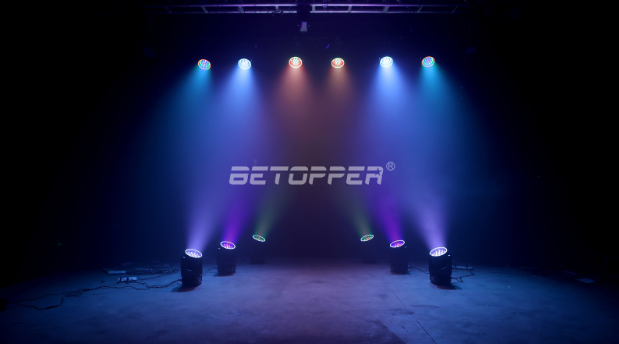Stage lighting plays an important role in concerts. It does more than just illuminate the performers; it improves the mood, highlights key moments, and adds energy to the performance. A well-designed lighting setup can turn an ordinary concert into the best visual and emotional concert.
The Role of Stage Lighting
Lighting helps create the right atmosphere for each song. A slow, emotional song might have soft, warm lighting, while a high-energy performance could include flashing and colorful lights. The right lighting guarantees that the audience stays engaged and focused on the stage.
Types of Lights Used in Concerts
Concert lights have different types of lighting fixtures, each with its own purpose.
- Spotlights focus on the lead singer or important band members.
- Wash lights cover the entire stage with soft lighting, setting the background mood.
- Beam lights create sharp, intense effects that add drama to the performance.
- Strobe lights flash quickly, enhancing fast-paced music.
- LED panels provide dynamic lighting that can change colors and patterns during the show.
Color and Mood
Color plays an important role in lighting design. Red creates excitement and intensity, often used for rock and metal performances. Blue gives a calm, emotional feel, making it perfect for slow songs.
Green adds a mysterious or eerie effect used in electronic music. Yellow and white bring clarity, helping to brighten moments. The right combination of colors can make each performance more impactful.
Synchronizing Lights with Music
Lighting is most effective when it moves in sync with the music. A well-planned lighting design follows the beat, tempo, and mood changes of the performance.
Modern lighting systems use controllers to program and automate lighting effects. DMX controllers allow precise adjustments, while MIDI triggers sync lights with instruments.
Lighting in Concert Stage Design
Lighting is a key element in shaping the concert experience. It improves the visual, directs attention to key moments, and creates different moods.
Advanced lighting effects such as synchronized displays, laser projections, and shifting colors add excitement to live performances.
Designers use various lighting types, including spotlights, floodlights, and LED panels, to build depth and create dynamic effects. The combination of light and shadow helps convey emotions, making each song more impactful.
Backdrops
Backdrops play a major role in setting the visual tone of a concert. They can be as simple as static images or as shown as animated digital displays that evolve with the music. High-resolution LED screens are used for their ability to produce vibrant, adaptable visuals that complement the performance.
Creative backdrops can change the stage into a storytelling platform. For example, a nature-inspired display with moving elements enhances the atmosphere of a folk or acoustic concert, while a futuristic cityscape fits an electronic or pop performance. The backdrop should always match the artist’s style and the overall theme of the show.
Stage Design
The structure of the stage itself is an important part of a concert’s visual presentation. Modern concert stages often feature multiple levels, moving platforms, and unique layouts to create excitement and provide space for elaborate performances. A well-planned stage ensures clear visibility for the audience and contains elements such as dancers, props, and special effects, improving the overall show.
Advanced Technology
Technology plays a growing role in stage design, making performances more immersive. Augmented reality (AR) and virtual reality (VR) elements create interactive experiences, blending digital effects with live action. Projection mapping turns ordinary surfaces into moving displays, adding a sense of wonder to the performance. These innovations help artists craft unique and visually captivating shows, pushing the boundaries of live entertainment.
Positioning and Effects
Lighting placement is just as important as the type of lights used. Front lights illuminate performers so the audience can see them clearly. Backlights add depth and create silhouettes for dramatic effects.
Side lights enhance movement and shadows, giving the stage a more dynamic feel. Overhead lighting highlights key areas and can be used to shift focus during the show. Effects like lasers, fog, and pixel mapping add an extra layer of visual excitement.
Avoiding Common Mistakes
- Poor lighting can ruin the concert experience.
- Overly bright lights can be uncomfortable for both performers and the audience.
- Bad timing in lighting changes can disrupt the flow of the performance.
- Using the wrong colors can confuse the audience instead of making the mood.
The Future of Concert Lighting
Technology has transformed concert lighting, making it more advanced and visually stunning. Wireless systems allow more flexible setups. LED lights provide energy-efficient solutions with customizable colors. Automated moving lights adjust positions and effects during the show.
Some concerts even use augmented reality projections mixed with real lighting for futuristic effects. These advancements continue to push the boundaries of what is possible in live performances.
Conclusion
Stage lighting is more than just a technical aspect of a concert. It is an art that enhances the music, engages the audience, and improves the overall experience. A well-executed lighting design can make a concert feel larger than life, leaving a lasting impression on everyone in attendance. By combining colors, effects, and precise timing, lighting designers help bring music to life in a spectacular way.



































